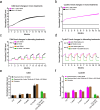This is a preprint.
WEE1 inhibition delays resistance to CDK4/6 inhibitor and antiestrogen treatment in estrogen receptor-positive breast cancer
- PMID: 39345487
- PMCID: PMC11429701
- DOI: 10.1101/2024.09.15.613122
WEE1 inhibition delays resistance to CDK4/6 inhibitor and antiestrogen treatment in estrogen receptor-positive breast cancer
Abstract
Although endocrine therapies and Cdk4/6 inhibitors have produced significantly improved outcomes for patients with estrogen receptor positive (ER+) breast cancer, continuous application of these drugs often results in resistance. We hypothesized that cancer cells acquiring drug resistance might increase their dependency on negative regulators of the cell cycle. Therefore, we investigated the effect of inhibiting WEE1 on delaying the development of resistance to palbociclib and fulvestrant. We treated ER+ MCF7 breast cancer cells with palbociclib alternating with a combination of fulvestrant and a WEE1 inhibitor AZD1775 for 12 months. We found that the alternating treatment prevented the development of drug resistance to palbociclib and fulvestrant compared to monotherapies. Furthermore, we developed a mathematical model that can simulate cell proliferation under monotherapy, combination or alternating drug treatments. Finally, we showed that the mathematical model can be used to minimize the number of fulvestrant plus AZD1775 treatment periods while maintaining its efficacy.
Conflict of interest statement
Competing Interests The author declares no competing interests.
Figures







Similar articles
-
Effective combination therapies in preclinical endocrine resistant breast cancer models harboring ER mutations.Oncotarget. 2016 Aug 23;7(34):54120-54136. doi: 10.18632/oncotarget.10852. Oncotarget. 2016. PMID: 27472462 Free PMC article.
-
Lasofoxifene as a potential treatment for aromatase inhibitor-resistant ER-positive breast cancer.Breast Cancer Res. 2024 Jun 7;26(1):95. doi: 10.1186/s13058-024-01843-4. Breast Cancer Res. 2024. PMID: 38849889 Free PMC article.
-
Targeting WEE1 Inhibits Growth of Breast Cancer Cells That Are Resistant to Endocrine Therapy and CDK4/6 Inhibitors.Front Oncol. 2021 Jul 1;11:681530. doi: 10.3389/fonc.2021.681530. eCollection 2021. Front Oncol. 2021. PMID: 34277427 Free PMC article.
-
A Review of Fulvestrant in Breast Cancer.Oncol Ther. 2017;5(1):17-29. doi: 10.1007/s40487-017-0046-2. Epub 2017 May 8. Oncol Ther. 2017. PMID: 28680952 Free PMC article. Review.
-
Impact of palbociclib combinations on treatment of advanced estrogen receptor-positive/human epidermal growth factor 2-negative breast cancer.Onco Targets Ther. 2016 Oct 11;9:6119-6125. doi: 10.2147/OTT.S77033. eCollection 2016. Onco Targets Ther. 2016. PMID: 27785059 Free PMC article. Review.
References
-
- Siegel R. L., Giaquinto A. N. & Jemal A. Cancer statistics, 2024. CA A Cancer J Clinicians 74, 12–49 (2024). - PubMed
-
- Waks A. G. & Winer E. P. Breast Cancer Treatment: A Review. JAMA 321, 288 (2019). - PubMed
-
- Morrison L., Loibl S. & Turner N. C. The CDK4/6 inhibitor revolution — a game-changing era for breast cancer treatment. Nat Rev Clin Oncol 21, 89–105 (2024). - PubMed
-
- Boumahdi S. & De Sauvage F. J. The great escape: tumour cell plasticity in resistance to targeted therapy. Nat Rev Drug Discov 19, 39–56 (2020). - PubMed
Publication types
Grants and funding
LinkOut - more resources
Full Text Sources
